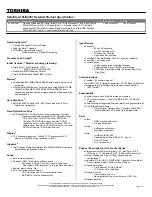
112
SMART
Self-Monitoring, Analysis and Reporting Technology (SMART) is an emerging technology that provides
near-term failure predictions for hard drives. When SMART is enabled the hard drive monitors
predetermined drive attributes that are susceptible to degradation over time. If a failure is likely to
occur. SMART makes a status report available so that the LifeBook can prompt the user to back up
the data on the drive. Naturally not all failures are predictable. SMART predictability is limited to those
attributes which the drive can self-monitor. In those cases where SMART can give advance warning,
a considerable amount of precious data can be saved.
SRAM
Static random access memory. A specific technology of making RAM which does not require periodic
data refreshing.
Status Indicator
A display which reports the condition of some portion of your hardware. On your notebook this is an
LCD screen just above the keyboard.
Stereo (audio)
A system using two channels to process sound from two different sources.
Stroke (keyboard)
The amount of travel of a key when it is pressed from resting to fully depressed.
Suspend
To make inoperative for a period of time. Your notebook uses various suspension states to reduce
power consumption and prolong the charge of your battery.
SVGA
Super VGA.
S-Video
Super Video. A component video system for driving a TV or computer monitor.
System Clock
An oscillator of fixed precise frequency which synchronizes the operation of the system and is counted
to provide time of day and date.
TFT
Thin Film Transistor - A technology for flat display panels which uses a thin film matrix of transistors
to control each pixel of the display screen individually.
UL
Underwriters Laboratories - An independent organization that tests and certifies the electrical safety
of devices.
VGA
Video Graphics Array. A video display standard originally introduced by IBM with the PS/2 series of
personal computers.



































